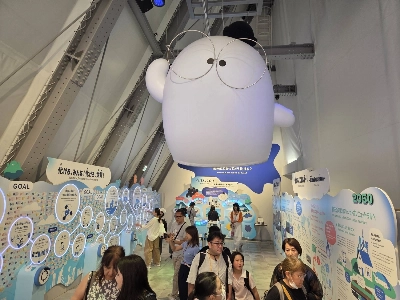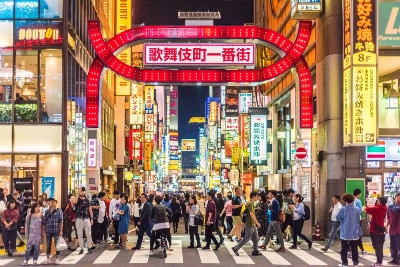The beverage giant Suntory Holdings Ltd., together with nine other companies and Yamanashi Prefecture, held a ceremony on Oct. 11 to mark the start of a demonstration experiment at a large-scale power-to-gas (P2G) system for using renewable electricity to produce hydrogen fuel at Green Hydrogen Park — Hakushu.
This Yamanashi Model P2G System has started to supply green hydrogen to the Suntory Minami Alps Hakushu Water Plant. It also aims to use the hydrogen at the Suntory Hakushu Distillery. The system could produce 2,200 tons of hydrogen annually if operated nonstop, enabling a reduction in carbon dioxide emissions of 16,000 tons.
Since Japan formulated the world’s first national hydrogen policy in 2017, the Basic Hydrogen Strategy, hydrogen has been considered one of the key energy sources for realizing a decarbonized society.
In line with this strategy, Suntory has been exploring ways not only to achieve its own decarbonization but also to collaborate with broader stakeholders to advance decarbonization of society.
The company’s environmental vision toward 2050 sets the goal of achieving net-zero emissions of greenhouse gases across its entire value chain, but Masaaki Fujiwara, its chief sustainability officer, believes that the new hydrogen solution has the potential to achieve much besides its 2050 goals.
The Suntory Green Hydrogen Vision, announced this June as part of a medium- to long-term plan for utilizing hydrogen, links hydrogen to the fundamental corporate slogan of “Sustained by Nature and Water.”
For the company, a maker of consumer goods focused on beverages, water is the lifeline of its business activities. Fujiwara said, “As hydrogen is an energy source that is born from water and returns to water, I strongly felt that we could contribute to the implementation of hydrogen solutions in society.”
Through the use of the Yamanashi Model P2G System and its green hydrogen at Suntory’s production sites, the initiative aims to build a hydrogen supply chain using water and renewable energy, both produced in Yamanashi.
The system is supported by companies from a variety of industries that possess the necessary expertise and key technologies. For instance, Fujiwara said, fiber manufacturer Toray produces the polymer membranes essential for hydrogen generation.
He also emphasized, “Yamanashi Prefecture has been playing a significant role.” The prefecture has long focused on renewable energy, leveraging its abundant water resources for hydroelectric power and its ample sunshine for solar power. “They also established a hydrogen strategy early on. The local leadership was exceptionally strong,” Fujiwara said. This robust trust relationship with the local government underpins the project’s stable advancement.
In Phase 1 of the Suntory Green Hydrogen Vision, green hydrogen will be used at the Hakushu Water Plant, serving as a heat source for the beverage sterilization process. Suntory also aims to use it as a heat source in the direct-fired distillation of whisky at the Suntory Hakushu Distillery, drawing attention as an example of decarbonizing whisky production.
“Pumping up ground water fostered in Suntory’s Natural Water Sanctuary within the prefecture and electrolyzing it using renewable energy generated in the prefecture to create hydrogen — I believe we can call this a completely locally produced energy for local consumption,” Fujiwara said. The company conducts water-source conservation areas called Suntory Natural Water Sanctuaries at 26 locations across its production sites, including Hakushu.
In solar power generation, surpluses can occur because demand fluctuates depending on factors such as the time of day and weather. Fujiwara pointed out that using this surplus at the hydrogen plant will increase the efficiency of the use of solar power.
Fujiwara said the data obtained through the demonstration experiment will be essential for clarifying the profitability of the hydrogen produced by the system and determining appropriate pricing for future commercialization.
In Phase 2, starting in 2027, the company plans to work with its partners to create and operate the entire value chain of green hydrogen, from production to sales, with an aim to expand the initiative beyond the two plants. The potential sales destinations are within Yamanashi Prefecture, as well as the Tokyo metropolitan area.
The future outlook for hydrogen utilization at Suntory’s own facilities is also diverse. “At our production sites, we are considering the use of hydrogen for mobility, such as long-distance transport trucks, on-site shuttle buses and forklifts,” Fujiwara said. The company also aims to roll out the technology through the framework of the Central Japan Hydrogen and Ammonia Association, starting with using hydrogen as a heat source at the Suntory Chita Distillery in Aichi Prefecture while aiming to introduce hydrogen at the Suntory Takasago Plant in Hyogo Prefecture in the early 2030s.
To further spread the use of hydrogen, ways to transport and distribute it must be established. For this, Suntory is engaging Tomoe Shokai, a company headquartered in Tokyo that has expertise in providing total solutions for gas products and services.
Fujiwara expressed a desire to take on the challenge of adding new value to hydrogen from various perspectives. “For example, hydrogen is a substance with high antioxidant capacity. We could leverage such functionality to develop new products. On the other hand, what happens if hydrogen is used in cooking? Compared to gas, hydrogen allows cooking at higher combustion temperatures. At the same time, since water vapor is generated when hydrogen burns, moisture in ingredients can remain unchanged,” he said. He believes that promoting these new values is key to accelerating the widespread use of hydrogen: “Through market development, we will be working to create new demand for hydrogen.”
Fujiwara also emphasized that wider and deeper collaboration with more companies from other industries will be essential not only for the production and distribution of hydrogen but also for developing markets and demand for this new energy and creating new products and services.
The company is an outsider to the conventional energy industry, but it has a strength in its closeness with the public as a manufacturer of consumer goods. Fujiwara believes this will help it communicate the current state of the energy transition to the public and raise social awareness of new energies.


























With your current subscription plan you can comment on stories. However, before writing your first comment, please create a display name in the Profile section of your subscriber account page.